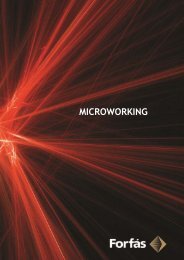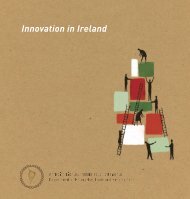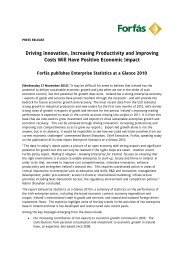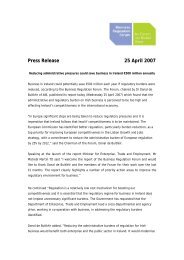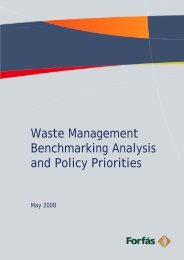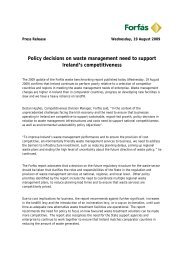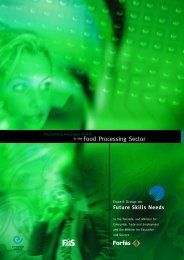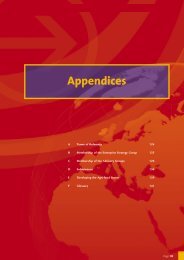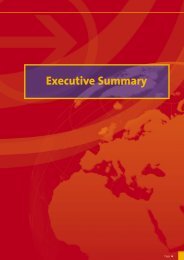Forfas 2009 - The National Documentation Centre on Drug Use
Forfas 2009 - The National Documentation Centre on Drug Use
Forfas 2009 - The National Documentation Centre on Drug Use
You also want an ePaper? Increase the reach of your titles
YUMPU automatically turns print PDFs into web optimized ePapers that Google loves.
Research Strengths in Ireland: A Bibliometric Study of the Public<br />
Research Base<br />
Forfás and the HEA began a study during the year designed to optimise the alignment<br />
between publicly funded research and the enterprise base. <str<strong>on</strong>g>The</str<strong>on</strong>g> study is designed to paint a<br />
nati<strong>on</strong>al picture of research activity, assess alignment between public and private activity<br />
and identify synergies and gaps. This will inform public policy <strong>on</strong> future investment and the<br />
development of research supports to ensure ec<strong>on</strong>omic value for the investment in the future.<br />
One comp<strong>on</strong>ent of the study is a bibliometric analysis of the Irish public research base.<br />
<str<strong>on</strong>g>The</str<strong>on</strong>g> bibliometric study profiled research activity and areas of existing and emerging research<br />
strengths across the public research base. <str<strong>on</strong>g>The</str<strong>on</strong>g> study focused <strong>on</strong> a ten-year period (1998 to<br />
2007) and the research disciplines were mapped with reference to discipline categories linked<br />
to the OECD Fields of Science (FoS) Classificati<strong>on</strong>. <str<strong>on</strong>g>The</str<strong>on</strong>g> analysis and the report are based<br />
solely <strong>on</strong> publicati<strong>on</strong> and citati<strong>on</strong> data.<br />
<str<strong>on</strong>g>The</str<strong>on</strong>g> report provides evidence of the transformati<strong>on</strong> that has taken place in the research<br />
envir<strong>on</strong>ment in Ireland over the ten year period:<br />
40<br />
<str<strong>on</strong>g>The</str<strong>on</strong>g> published output of the research base in Ireland more than doubled between 1998<br />
and 2007 at a time when the output of G7 countries remained static. Irish research<br />
output in 2007 was 33 per cent higher than the average for the period 2002 to 2006,<br />
more than double the growth rate of a group of comparator countries examined. In<br />
most of the fields of science examined, Ireland accounts for between 0.3 and 0.4 per<br />
cent of world papers. In biological sciences, where growth is str<strong>on</strong>g, its share is higher<br />
(around 0.5 per cent) and it is higher again in agriculture (0.6 per cent) and agricultural<br />
biotechnology (1.5 per cent). Ireland also performs well in computer science and<br />
electr<strong>on</strong>ic engineering, although these areas make str<strong>on</strong>g use of n<strong>on</strong>-journal outputs.<br />
Ireland’s share of world citati<strong>on</strong>s, at 0.64 per cent in 2007, is greater than its share of<br />
publicati<strong>on</strong>s (0.5) indicating above average citati<strong>on</strong> impact. Whereas Ireland ranks 18 th<br />
by volume, it ranks 8 th <strong>on</strong> citati<strong>on</strong> impact and has overtaken Australia and Finland <strong>on</strong><br />
this measure.<br />
At subject level, health research and physical sciences perform well in terms of citati<strong>on</strong><br />
impact. Competiti<strong>on</strong> in biological sciences c<strong>on</strong>strains relative performance but<br />
agricultural biotechnology is str<strong>on</strong>ger. Citati<strong>on</strong> impact in physics and materials and in<br />
chemistry is rising and nanotechnology is above average.<br />
Inter-instituti<strong>on</strong>al collaborati<strong>on</strong> is relatively low and collaborati<strong>on</strong> with Northern<br />
Ireland is very low compared to typical inter-instituti<strong>on</strong>al collaborative links in other<br />
countries. Queens University Belfast (QUB) links to 1 per cent of output for UCD and 2<br />
per cent for TCD whereas QUB and University of Ulster share 10 per cent of the<br />
University of Ulster's activity. Collaborati<strong>on</strong> between TCD and UCD is less than 3 per<br />
cent.<br />
<str<strong>on</strong>g>The</str<strong>on</strong>g> number of papers cited more than four times the world average is used as an<br />
indicator of scientific excellence. 6.2 per cent of Irish papers fall into this category,<br />
slightly ahead of the figure for the UK (6.1 per cent).



